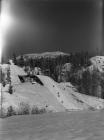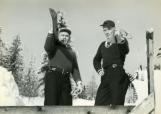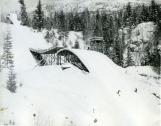1
January 15, 1939 was the official opening of the new "Big Bend" jump. The benefits of this jump over the Big Hill were numerous: it was located just north of town, within easy walking distance, one didn't have the "arduous" climb up the slopes of Mt. Revelstoke to reach it; and most importantly, it was easier to maintain. So much energy went into maintaining a jump and prepping it for competitions that this was a major consideration. The new hill was said to be a great improvement over the old hill "which shook the nerve of even the best jumpers." Jumps of over 200' were possible at this new hill.3
Paul Salva on the White Rock and Big Bend jumpslate 1930's, early 1940's
Revelstoke, British Columbia
 Credits:
Credits:Paul Salva
4
Packing the slope of the Big Bend Jump1940's
Revelstoke, British Columbia
 Credits:
Credits:Revelstoke Museum and Archives
6
Revelstoke had won the opportunity to host the Western Canada Ski Championships in 1939 before they even had a hill on which to stage the competition. Laborers had been hired at $.40 an hour to work on the jumping hill as well as the downhill and slalom courses. The National Park had given $200 the previous winter for development to do the work. At the official opening of the new hill, both Gunnar and Hans Gunnarsen gave exhibition jumps.Hans and Gunnar had been active in skiing their entire lives. Hans had been a frequent runner-up to Bob Lymburne and in 1935 he won the B.C. Jumping Championship in Revelstoke. At the same tournament, Gunnar made the longest jump of the day with 200' in perfect form.
7
Gunnar and Hans Gunnarsenlate 1930's (?)
Revelstoke, British Columbia
 Credits:
Credits:Revelstoke Museum and Archives
8
Hans Gunnarsen won two jumping events in 1940. He placed first at the Canadian Amateur Ski Association sanctioned meet in Revelstoke and he won the Canadian Jumping Championship in Banff, Alberta. In November 1944, he was killed in action in Holland.10
The 1939 tournament was a huge success for Revelstoke. "Ski trains" arrived from Vancouver, packed with spectators who wanted to partake in the festivities. The departure was broadcast on radio and photo-journalists recorded the train's arrival in Revelstoke. Horse drawn sleighs met people at the Revelstoke station to take them to various accommodations or restaurants. The mayor, Walter Hardman, mixed with the crowd and welcomed as many people as possible.Another important aspect of the 1939 tournament was the slalom and downhill courses created for this tournament. These courses were on the eastern edge of town. The slalom course was run on the slopes above the Campbell farm and the downhill was a run cut from mile 11 on the Mt. Revelstoke road and descending a dizzying 2200' in 1-1/4 miles to the Campbell farm at the base. The average gradient of the downhill course was 38 degrees.
"The course is one of the best in the world," said Peter Vadja, Swiss ski instructor who coached at University of British Columbia.
12
Finish Line, Slalom Race, Western Canadian Ski Championship1939
Revelstoke, British Columbia
 Credits:
Credits:Barbara Vigue
13
The Western Canadian Ski Championship of 1939 was a huge event for Revelstoke. As with all tournaments, the banquets, social dances and awards ceremonies were an important part and showed the entire community's support of the event.The 1939 tournament was the last "big" tournament before the war. Events continued annually for Juniors, though there were no events in Revelstoke between January 1941 and February 1943.
14
Banquet, Western Canadian Ski Championship1939
Revelstoke, British Columbia
 Credits:
Credits:Barbara Vigue


